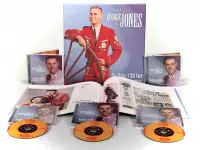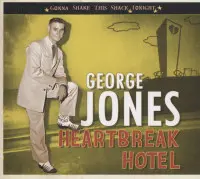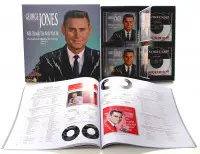George Jones Country Music Jamboree (LP, 10inch, Ltd.)

* incl. VAT / plus shipping costsDepending on the country of delivery, the VAT at checkout may vary.
Ready to ship today,
delivery time** appr. 1-3 workdays
- catalog number:BAF11032
- weight in Kg 0.3
George Jones: Country Music Jamboree (LP, 10inch, Ltd.)
- 1:1 reproduction of a super rare Japanese George Jones LP in Bear Family's exclusive series of 10inch vinyl releases, a limited collector's edition!
- Reissue with the original cover.
- The genuine version with 8 single tracks was released in 1960 on the Japanese Mercury label, catalog number MPM 1024.
- Originals are rarely offered on the collector's market, and when they are, they often go for several hundred dollars a piece!
- Bear Family has added four bonus tracks, Just Little Boy Blue, Tall Tall Trees, Sparkling Brown Eyes and Too Much Water - all recordings first released on Mercury in the USA between 1956 and 1960.
- Carefully remastered for the highest sound quality and pressed on high quality vinyl!
- Limited to 500 colored copies!
In 1954, he made his first recordings for Starday, performed at the Louisiana Hayride, and eventually conquered Nashville's Grand Ole Opry in 1956. In 1957, he signed with Mercury and from then on developed his very own style of classic honky tonk.
Video von George Jones - Country Music Jamboree (LP, 10inch, Ltd.)
Article properties:George Jones: Country Music Jamboree (LP, 10inch, Ltd.)
Interpret: George Jones
Album titlle: Country Music Jamboree (LP, 10inch, Ltd.)
Genre Country
Label Bear Family Records
- Preiscode BAF
- Geschwindigkeit 33 U/min
- Record Grading Mint (M)
- Sleeve Grading Mint (M)
- Edition 2 Limited Edition
- Vinyl record size LP (10 inch)
Artikelart LP
EAN: 5397102110320
- weight in Kg 0.3
| Jones, George - Country Music Jamboree (LP, 10inch, Ltd.) LP 1 | ||||
|---|---|---|---|---|
| 01 | White Lightning | George Jones | ||
| 02 | Into My Arms Again | George Jones | ||
| 03 | Opry Rag | George Jones | ||
| 04 | Don't Stop The Music | George Jones | ||
| 05 | Just Little Boy Blue | George Jones | ||
| 06 | Tall Tall Trees | George Jones | ||
| 07 | Who Shot Sam | George Jones | ||
| 08 | Long Time To Forget | George Jones | ||
| 09 | Treasure Of Love | George Jones | ||
| 10 | Jesus Wants Me | George Jones | ||
| 11 | Sprakling Brown Eyes | George Jones | ||
| 12 | Too Much Water | George Jones | ||
George Jones
12.9. 1931 Saratoga - Texas / 26. 04. 2013
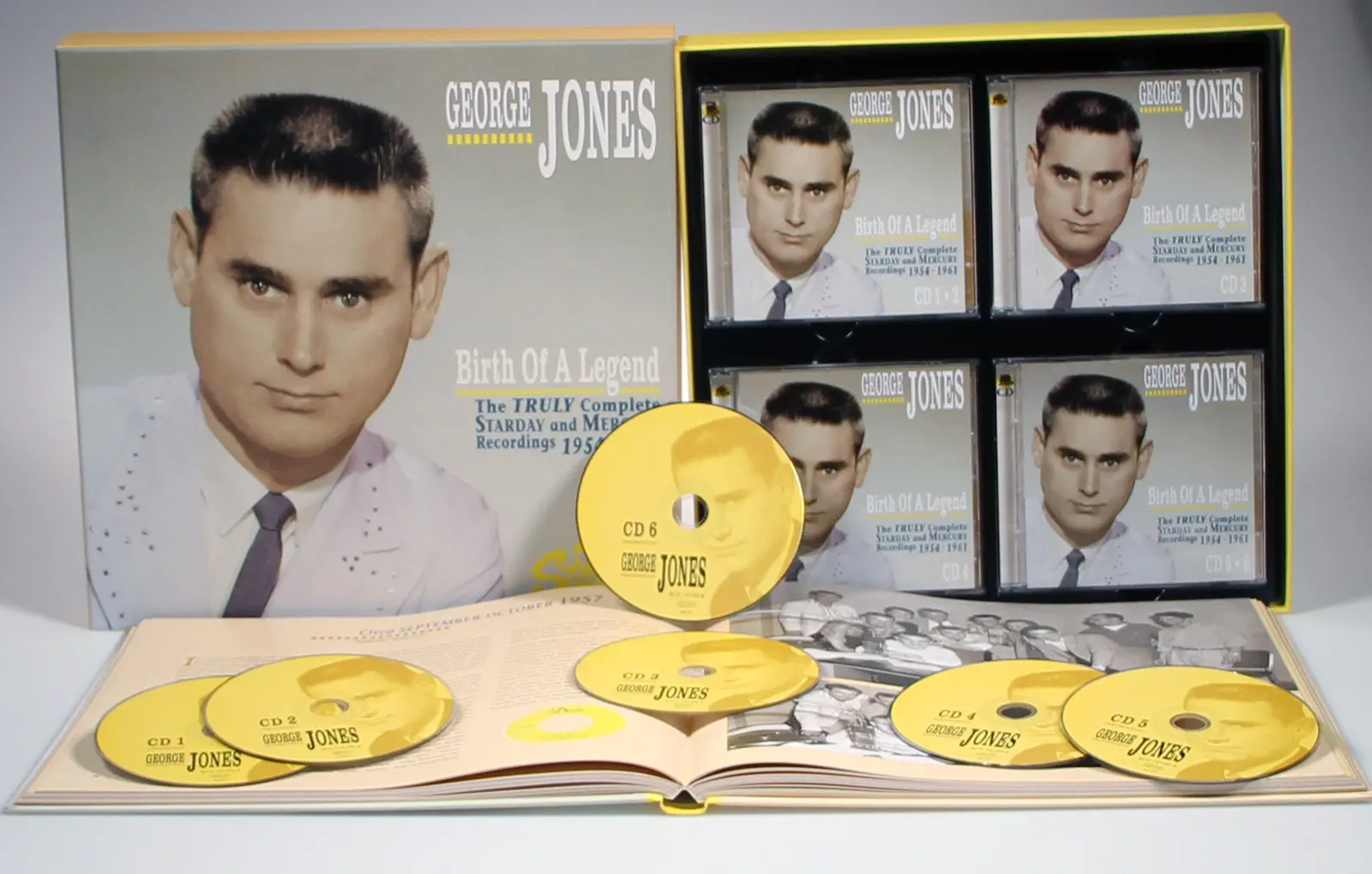 Record Labels: Starday, Mercury, Longhorn, Power Pak, Hillside, United Artists, Musicor, RCA, Intercord, Ace, Rounder, Epic.
Record Labels: Starday, Mercury, Longhorn, Power Pak, Hillside, United Artists, Musicor, RCA, Intercord, Ace, Rounder, Epic.
First Top Ten Hit: Why Baby, Why (1955)
First No. 1 Hit: White Lightning (1959)
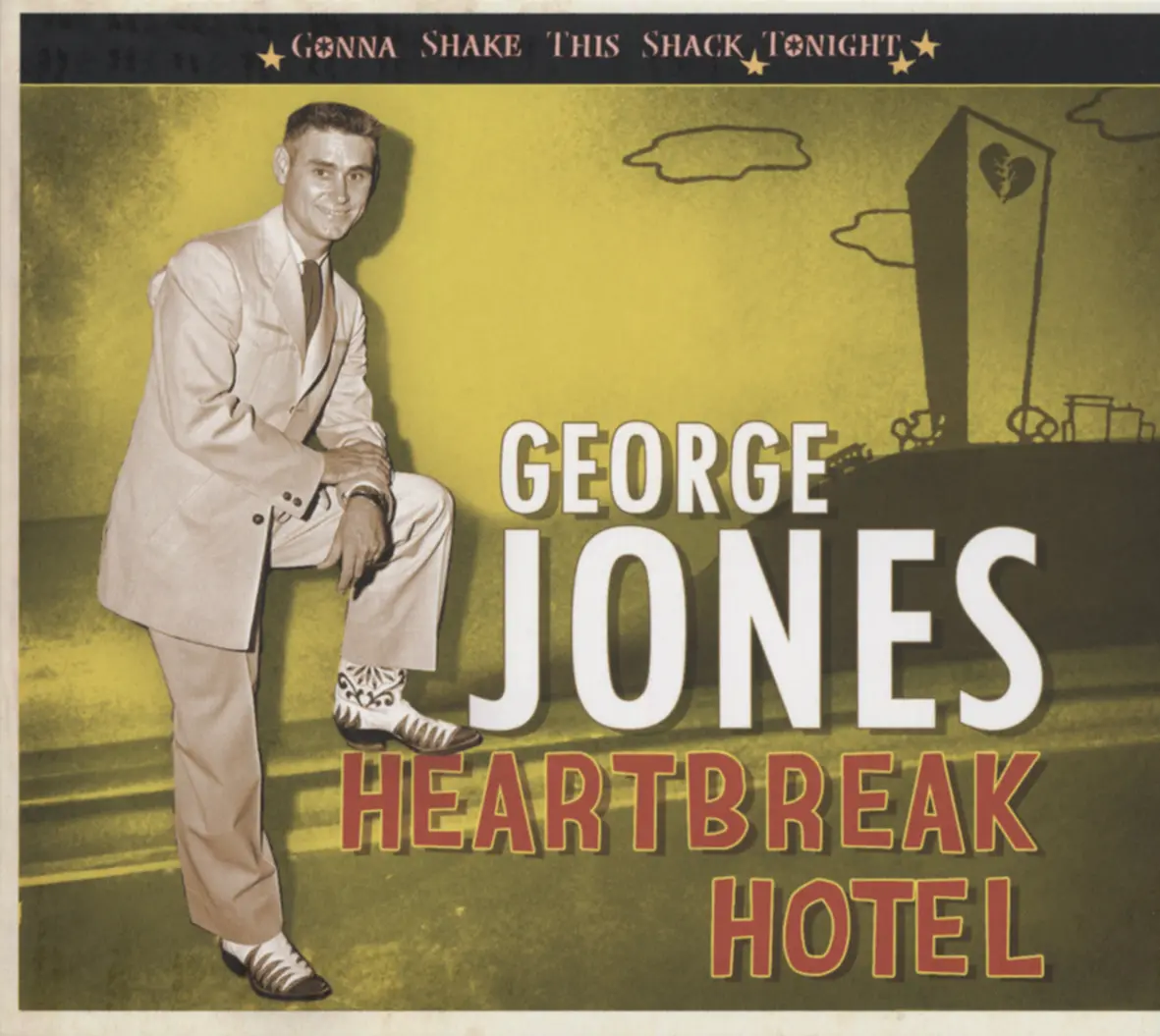 In November, 1953, he was fresh out of the Marines, having joined two years earlier in the wake of an unraveling marriage. Before taking the oath, he'd been a denizen of honky tonk stages in and around Beaumont, Texas. Born in a rough-cut log house near Saratoga in East Texas' mysterious, often violent Big Thicket region on September 12, 1931, hillbilly music surrounded him as a kid; his singing voice turned heads even when he was an adolescent.
In November, 1953, he was fresh out of the Marines, having joined two years earlier in the wake of an unraveling marriage. Before taking the oath, he'd been a denizen of honky tonk stages in and around Beaumont, Texas. Born in a rough-cut log house near Saratoga in East Texas' mysterious, often violent Big Thicket region on September 12, 1931, hillbilly music surrounded him as a kid; his singing voice turned heads even when he was an adolescent.
Jones wasn't back long when he heard about Starday, a new record company. Lefty Frizzell's ex-manager Jack Starnes and hard-bitten Houston area railroader-turned-juke box and slot machine impresario-turned record label owner, distributor and retailer Harold 'Pappy' Daily co-founded it in 1952. George's buddy, aspiring local singer Sonny Burns, had dealings with them, so Jones returned to playing the dives around the area, expanding his profile in 1954 as a disc jockey over KTRM. He soon found Starday interested in auditioning him.
His audition and first session took place in Jack Starnes' living room-turned-improvised recording studio. With an amateur's passion for the era's great singers, he tried to emulate the best of all of them as he sang--until Daily asked with great sincerity, "George, you've sung like Roy Acuff, Lefty Frizzell, Hank Williams and Bill Monroe. Can you sing like George Jones?"
No Money In This Deal, the first single, came from that session. It didn't take. Neither did the next five singles.
It was single number seven, the Hankish Why Baby Why that landed in the Top Ten in 1955. More Starday hits followed. After a brief, abortive alliance between Starday and Mercury Records, Daily, who still co-owned Starday with his partner Don Pierce, (Jack Starnes had departed earlier) fell out with Pierce in 1958. When the smoke cleared, Pierce took Starday; George wound up contracted to Pappy and remained a Mercury artist. Pappy kept his hand in the regional market. He'd formed Houston-based D and Dart Records as a regional operation aimed at finding new talent, Gabe Tucker helping him run things. Glad Music, Daily's new publishing company, would handle that end of things.
Jones came up with some landmark hits on Mercury, among them Color Of The Blues and the Chuck Berry-influenced White Lightning, from the pen of Daily discovery and Jones buddy, KTRM disc jockey-singer-composer J. P. 'The Big Bopper' Richardson. He originally recorded his hard-driving rocker Chantilly Lace for D, until Mercury, who'd initially passed on it, re-released it nationally. That put it over the top and made the Bopper and fulltime rock star from later '58 until February 3, 1959, when the small private plane carrying him, Buddy Holly and Ritchie Valens crashed killing everyone on board.
At Mercury, Jones's vocal style began evolving, his keening, edgy nasality morphed into a more distinctive type of phrasing. Overtones of Hank and Acuff remained, but Jones's voice moved into a lower register. He could wrench emotion out of a phrase or lyric by bearing down on it as he sang. The new maturity manifested itself in his final Mercury hits: The Window Up Above and especially the #1 single Tender Years, where the formerly twangy accompaniment replaced by muted Nashville Sound backing.
 The new Jones style quickly began influencing others, Buck Owens among them. Interviewed in 1988, Buck confirmed that point. "I thought that George was the greatest thing since sliced bread. I could not help it and later on in the last years I've tried to make a concerted effort to not get into that, but if you listen on (my records in the) early years, you're sure gonna hear George because he was a big influence on me as far as the singers go," he said. As time passed, George began singing in lower registers that combined with his distinctive phrasing his singular sound brought more admiration among fans and his peers.
The new Jones style quickly began influencing others, Buck Owens among them. Interviewed in 1988, Buck confirmed that point. "I thought that George was the greatest thing since sliced bread. I could not help it and later on in the last years I've tried to make a concerted effort to not get into that, but if you listen on (my records in the) early years, you're sure gonna hear George because he was a big influence on me as far as the singers go," he said. As time passed, George began singing in lower registers that combined with his distinctive phrasing his singular sound brought more admiration among fans and his peers.
Pappy came to know Mercury executive Art Talmadge, who'd left to join United Artists Records. Daily and Jones followed him there. The label was only four years old. Originally created to distribute soundtracks from UA-produced films, it branched out, becoming a hip jazz label and then broadened into other areas. Their newly-created country division consisted mainly of Daily acts with Jones as the flagship, Pappy serving as UA's de facto country producer.
Jones's relationship with Daily was business only, and fostered deep resentment that hadn't abated in his 1996 autobiography 'I Lived To Tell It All,' where he wrote bitterly, "I made a lot of money for Pappy Daily, Starday and Mercury. Basically, I was a naïve guy who was overly trusting of some people who proved to be untrustworthy. I was never paid royalties on a regular basis. It became very frustrating to hear my songs on the radio, see them listed high on the charts and not have enough money to hire a band."
His two-year UA contract yielded exactly 151 recordings. Some singles and albums from that period stand among his most memorable. Every album was 'produced by Pappy Daily.' Or so it seemed. In 2001, Jones clarified their 16 year studio relationship, which continued through his 1965-1970 stint with Talmadge's Musicor Records. "A lot of people think (Pappy) was the producer, but he really wasn't. He timed the songs in the studio and he wrote out the paperwork. That was about all he did. I worked with the musicians myself and we worked out the arrangements. I basically left it up to the musicians after we run through the songs. I wanted them to be more a part of the production."
Jones created many great moments in the studio during his UA phase. Some were captured on tape, some not. His legendary reputation as a drinker and hellraiser already established, his stature continued to rise. Many Nashville insiders began hanging at George's sessions, both to marvel at the voice and to see what whiskey-fueled mischief he'd make this time. One frequent sideman explained that while Jones was usually well-lubed throughout a recording session, a certain sweet spot existed. Too few drinks didn't loosen him up sufficiently; too many washed out a session. An amount of alcohol in between those extremes unleashed every bit of his unrestrained, uninhibited power.
Excerpt from the book BCD16818 - George Jones - She Thinks I Sttill Care - Read more at:https://www.bear-family.com/jones-george-she-thinks-i-still-care-62-64-5-cd.html Copyright © Bear Family Records
Read more at: https://www.bear-family.com/jones-george/
Copyright © Bear Family Records

Ready to ship today, delivery time** appr. 1-3 workdays
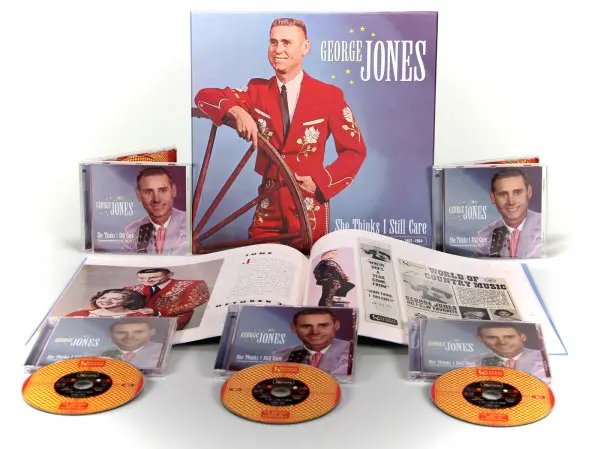
Ready to ship today, delivery time** appr. 1-3 workdays

Ready to ship today, delivery time** appr. 1-3 workdays

only 1x still available
Ready to ship today, delivery time** appr. 1-3 workdays

Ready to ship today, delivery time** appr. 1-3 workdays

This article is deleted and can no longer be ordered!

This article is deleted and can no longer be ordered!

Ready to ship today, delivery time** appr. 1-3 workdays

Ready to ship today, delivery time** appr. 1-3 workdays

Ready to ship today, delivery time** appr. 1-3 workdays

Ready to ship today, delivery time** appr. 1-3 workdays

Ready to ship today, delivery time** appr. 1-3 workdays

Ready to ship today, delivery time** appr. 1-3 workdays

This article is deleted and can no longer be ordered!

Ready to ship today, delivery time** appr. 1-3 workdays

Ready to ship today, delivery time** appr. 1-3 workdays

Ready to ship today, delivery time** appr. 1-3 workdays

Ready to ship today, delivery time** appr. 1-3 workdays

Ready to ship today, delivery time** appr. 1-3 workdays









